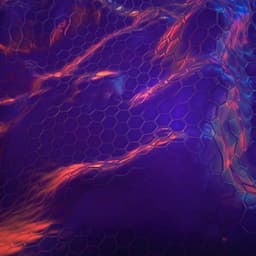
Physics
Correlated states in magic angle twisted bilayer graphene under the optical conductivity scrutiny
M. J. Calderón and E. Bascones
This groundbreaking research by María J. Calderón and Elena Bascones explores the intriguing behaviors of magic angle twisted bilayer graphene, particularly focusing on optical conductivity and the nature of correlated electron states like nematic order. Discover how these findings shed light on symmetry-breaking states and the fascinating implications for charge neutrality points.
~3 min • Beginner • English
Introduction
The study investigates how symmetry breaking in magic-angle twisted bilayer graphene (TBG) manifests in optical conductivity, aiming to distinguish correlated electronic states—particularly at the charge neutrality point (CNP)—from non-correlated behavior. In moiré systems like TBG at the magic angle (~1.1°), extremely flat bands enhance interaction effects, producing insulating and superconducting phases upon doping. STM reports show band widening when the chemical potential lies within the flat bands and signatures of nematicity (broken C3 rotational symmetry), while some transport measurements at CNP show activated behavior consistent with gap opening. It remains debated whether correlated states involve only the flat bands or also higher-energy bands separated by tens of meV, and whether observed gaps at CNP are electronic (e.g., C2T breaking) or substrate-induced. The purpose is to use theoretical optical conductivity to provide clear, symmetry-sensitive signatures that can identify and characterize these correlated states and clarify the role of lattice relaxation and higher-energy bands.
Literature Review
Methodology
The study employs 10-band tight-binding models for each valley and spin that respect the symmetries and fragile topology of the continuum TBG model. Two parameter sets represent different twist angles and lattice relaxation: a fully relaxed (FR) model (θ ≈ 0.9°) derived from ab initio k·p including in-plane and out-of-plane relaxation, and a partially relaxed (PR) model (θ ≈ 1.05°) from the continuum model with vertical corrugation (15% suppression of interlayer same-sublattice hopping). The effective moiré-orbital basis includes p orbitals on AA (triangular) regions, p_x and p_y on AB/BA (hexagonal) regions, and s orbitals on SP (kagome) regions; the flat bands are largely p_x/p_y-like with additional character at Γ.
Symmetry-breaking orders are introduced at mean-field level: (i) α breaks C2T symmetry by lifting degeneracies among p-like orbitals, gapping Dirac points at K/K′; (ii) η and (iii) β are nematic bond orders breaking C3 rotational symmetry by making one of the Y-direction hoppings inequivalent to the others (different microscopic interorbital hopping patterns for η vs β). Orders η and α were obtained self-consistently in prior work; β is introduced phenomenologically.
Optical conductivity is computed in linear response using the Kubo formula for multiorbital systems with Peierls substitution; matrix elements are obtained as derivatives of orbital-dependent tight-binding terms with correct intra-cell positions accounted for. Valley and spin are assumed degenerate unless explicitly broken; reported spectra correspond to a single valley/spin and are identical for the others under this assumption. A small broadening (0.04 meV; 0.06 meV in specified low-frequency panels) is used for σxx(ω). The Drude weight is calculated directly from the Hamiltonian and current matrix elements without broadening. Interband transitions at q=0 are analyzed and labeled (γ1–γ6) to track features tied to specific regions in k-space (notably Γ, K, M) and to assess doping and order-parameter effects.
Key Findings
- Non-correlated baseline: At CNP, both PR (θ≈1.05°) and FR (θ≈0.9°) models have Dirac points at K and K′ with no Drude peak. Low-frequency optical conductivity is dominated by γ1 transitions (between flat bands), finite from zero frequency due to Dirac points. In PR, σ′(ω) peaks near ~2 meV, whereas DOS van Hove singularities at ~0.3 meV only weakly imprint σ′(ω) around ~0.6 meV, highlighting matrix-element effects. Higher-energy onsets correspond to γ2/γ4 near Γ; PR shows a sharp threshold peak, FR a shoulder. Doping empties/fully fills flat bands, opening a low-ω gap (forbidden γ1) and allowing γ5/γ6 transitions; metallic fillings yield a Drude peak.
- C2T-breaking (α) state: Gaps the Dirac cones at K/K′, producing activated behavior at CNP. Optical conductivity reflects a low-energy gap and spectral weight reorganization paralleling the DOS, providing a direct optical signature of C2T breaking.
- Nematic states (η, β): Do not open a global optical gap at CNP but break rotational symmetry, yielding direction-dependent σ′(ω). Inequalities among directions related by C3 (e.g., along X1 vs X2/X3; and X vs Y axes) appear, and differences extend beyond flat-band γ1 to higher-energy transitions (γ2, γ3, γ4), indicating that higher bands participate in the nematic state.
- Nematicity-induced Lifshitz transition: With increasing nematic order parameter, Dirac points shift in momentum and then in energy relative to μ at CNP, creating small electron and hole Fermi pockets. This converts the CNP semimetal into a metal and generates a finite Drude weight and low-frequency Drude peak at CNP. The effect occurs in both PR (η) and FR (β) models; FR’s lower flat band morphology (multiple maxima) makes it more susceptible to pocket formation for smaller order parameters.
- Drude anisotropy: The anisotropy of the Drude weight, e.g., between X1 and X2 or X1 and Y1 directions, exhibits sign changes depending on doping, order-parameter magnitude, lattice relaxation (PR vs FR), and the specific nematic order (η vs β). For example, in the FR model under η, the sign follows the order parameter sign, whereas PR under η or FR under β shows multiple sign reversals across doping/order-parameter space.
- Momentum- and doping-selective diagnostics: Transitions near Γ (γ2–γ4 thresholds) provide clearer nematic signatures and are at higher frequencies than γ1, aiding detection. Doping evolution of peak positions and spectral weight (including suppression/emergence of γ1 vs γ5/γ6) can reveal whether correlations involve higher-energy bands and distinguish electronic orders from static lattice effects.
- Sensitivity to lattice relaxation: Spectral characteristics (e.g., threshold peak vs shoulder, anisotropy sign maps, propensity for Lifshitz transition) differ markedly between PR and FR models, underscoring strong dependence on relaxation degree and band-structure details.
Discussion
The findings demonstrate that optical conductivity is a powerful, symmetry-sensitive probe to identify correlated states in magic-angle TBG and to differentiate among mechanisms. A C2T-breaking gap at CNP generates a clear low-energy optical gap and spectral weight reshaping. Nematic orders reduce rotational symmetry, producing directional anisotropies in σ′(ω) and modifying transitions beyond the flat bands, implying participation of higher-energy bands.
The study shows that nematicity can induce a Lifshitz transition at CNP, generating Fermi pockets and a finite Drude weight, thus transforming a nominal semimetal into a metal. This effect impacts multiple observables (transport, quantum oscillations, STM) and is highly sensitive to lattice relaxation and the specific nematic pattern, explaining potential sample-to-sample variability in anisotropy signs and magnitudes.
Doping evolution offers additional discrimination: rigid chemical-potential shifts without correlations imply fixed transition frequencies, whereas correlated states that disappear when flat bands are fully empty/filled should show peak shifts and spectral-weight transfer with doping. Momentum selectivity—using thresholds near Γ (γ2–γ4) versus higher-frequency features near K or M—can help localize where in k-space symmetry breaking is most impactful. Temperature- and doping-dependent suppression or emergence of γ1 relative to γ5/γ6 can distinguish C2T-breaking gaps from spin/valley-polarized or intervalley-coherent orders, given their different flavor-selective filling scenarios.
Strain or h-BN alignment may mimic some signatures, but their weaker dependence on doping/temperature provides a route to discriminate lattice versus electronic origins.
Conclusion
This work establishes theoretical benchmarks for using optical conductivity to identify correlated symmetry-breaking states in magic-angle TBG. Key contributions include: (i) clear optical signatures of C2T-breaking gaps at CNP; (ii) demonstration that nematicity produces directional anisotropies and can drive a Lifshitz transition at CNP with emergent Drude weight; (iii) mapping of Drude-weight anisotropy sign changes versus doping and nematic order, highlighting strong sensitivity to lattice relaxation and order type; and (iv) a momentum- and doping-resolved framework (γ1–γ6 transitions) to test whether higher-energy bands participate in the correlated state.
Future research directions suggested by the results include: systematic far-infrared optical studies across doping and temperature to track γ1–γ6 features and anisotropies; momentum-selective analysis by targeting thresholds near Γ versus higher-frequency K/M transitions; disentangling electronic nematicity from strain or substrate alignment via doping/temperature dependences; and extending theory to include excitonic effects or more complete interaction-driven self-energies to refine quantitative comparisons with experiment.
Limitations
- The optical response is computed within a band (quasiparticle) picture, neglecting excitonic effects and possible incoherent (Hubbard) bands; results primarily reflect quasiparticle contributions.
- Symmetry-breaking orders are treated at mean-field level (η and α previously obtained self-consistently; β phenomenological), which may not capture all fluctuation effects.
- Valley and spin degeneracies are assumed intact unless explicitly broken by an order; flavor-mixing interactions are not included in the hopping.
- Conclusions are based on two specific tight-binding parameter sets (PR θ≈1.05° with partial relaxation; FR θ≈0.9° with full relaxation); quantitative features can be sample-dependent due to relaxation and strain.
- A small artificial broadening is used for σ(ω); Drude weight is computed without broadening, which may differ from experimental scattering rates.
- Possible substrate-induced symmetry breaking (e.g., h-BN alignment) is not explicitly modeled, though its effects are discussed qualitatively.
Related Publications
Explore these studies to deepen your understanding of the subject.







